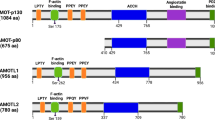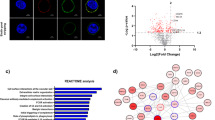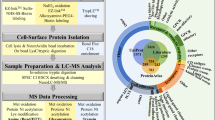Abstract
Using the Affymetrix array technology, we previously identified an EST strongly expressed in several metastatic cell lines. In the present study, we cloned the corresponding cDNA that encodes a new glycoprotein composed of 97 amino acids and containing a trans-membrane domain. Therefore, we named it SMAGP for Small trans-Membrane And Glycosylated Protein. SMAGP is strongly conserved during evolution. It is expressed by normal epithelia of various organs, the protein being notably localized to the lateral face of the plasma membrane of cohesive well-polarized epithelial cells. In addition, SMAGP contains binding domains for the protein 4.1 and the PDZ domain of MAGUK proteins. Similar protein features are observed in several cell-surface proteins involved via ternary complexes in intercellular processes leading to cytoskeleton assembly as well as intracellular signalling. Thus, SMAGP might similarly be involved in a scaffolding protein complex, and therefore participate in the epithelium organization or in subsequent functions. Immunohistochemical data obtained using human breast, colon and lung cancer samples sustain this hypothesis since they showed that, in both primary tumours and metastases, reduced expression and/or cytoplasmic redistribution of SMAGP is superimposable with low histological tumour differentiation features, namely a lack of epithelial cell polarity and disorganized tissue phenotype.
This is a preview of subscription content, access via your institution
Access options
Subscribe to this journal
Receive 50 print issues and online access
$259.00 per year
only $5.18 per issue
Buy this article
- Purchase on Springer Link
- Instant access to full article PDF
Prices may be subject to local taxes which are calculated during checkout








Similar content being viewed by others
Abbreviations
- PDZ:
-
postsynaptic density protein, disc-large, zonulin-1
- SH3:
-
Src homology 3
- MAGUK:
-
membrane-associated guanylate kinase homologue
- EST:
-
expressed sequence tag
- ORF:
-
open reading frame
References
Altschul SF, Madden TL, Schaffer AA, Zhang J, Zhang Z, Miller W and Lipman DJ . (1997). Nucleic Acids Res., 25, 3389–3402.
Biederer T, Sara Y, Mozhayeva M, Atasoy D, Liu X, Kavalali ET and Sudhof TC . (2002). Science, 297, 1525–1531.
Biederer T and Sudhof TC . (2001). J. Biol. Chem., 276, 47869–47876.
Brattain MG, Fine WD, Khaled FM, Thompson J and Brattain DE . (1981). Cancer Res., 41, 1751–1756.
Chambers AF, Groom AC and MacDonald IC . (2002). Nat. Rev. Cancer., 2, 563–572.
Claas C, Seiter S, Claas A, Savelyeva L, Schwab M and Zoller M . (1998). J. Cell Biol., 141, 267–280.
Florea L, Hartzell G, Zhang Z, Rubin GM and Miller W . (1998). Genome Res., 8, 967–974.
Fukata M and Kaibuchi K . (2001). Nat. Rev. Mol. Cell Biol., 2, 887–897.
Fukuda M, Lauffenburger M, Sasaki H, Rogers ME and Dell A . (1987). J. Biol. Chem., 262, 11952–11957.
Greenwood E . (2003). Nat. Rev. Cancer, 3, 549.
Grille AJ, Bellacosa A, Upson J, Klein-Szanto AJ, van Roy F, Lee-Kwon W, Donowitz M, Tsichlis PN and Larue L . (2003). Cancer Res., 63, 2172–2178.
Gunthert U, Hofmann M, Rudy W, Reber S, Zoller M, Haussmann I, Matzku S, Wenzel A, Ponta H and Herrlich P . (1991). Cell, 65, 13–24.
Hansen JE, Lund O, Engelbrecht J, Bohr H and Nielsen JO . (1995). Biochem. J., 308, 801–813.
Hunter KW, Broman KW, Le Voyer T, Luke L, Cozma D, Debies MT, Rouse J and Welch RD . (2001). Cancer Res., 61, 8866–8872.
Jeanplong F, Sharma M, Somers WG, Bass JJ and Kambadur R . (2001). Mol. Cell. Biochem., 220, 31–37.
Jensen LJ, Gupta R, Blom N, Devos D, Tamames J, Kesmir C, Nielsen H, Staerfeldt HH, Rapacki K, Workman C, Andersen CA, Knudsen S, Krogh A, Valencia A and Brunak S . (2002). J. Mol. Biol., 319, 1257–1265.
Kang Y, Siegel PM, Shu W, Drobnjak M, Kakonen SM, Cordon-Cardo C, Guise TA and Massagué J . (2003). Cancer Cell, 3, 537–549.
Kozak M . (1984). Nucleic Acids Res., 12, 857–872.
Lozano E, Betson M and Braga VMM . (2003). BioEssays, 25, 452–463.
Marfatia SM, Morais-Cabral JH, Kim AC, Byron O and Chishti AH . (1997). J. Biol. Chem., 272, 24191–24197.
Masuda M, Yageta M, Fukuhara H, Kuramochi M, Maruyama T, Nomoto A and Murkakami Y . (2002). J. Biol. Chem., 277, 31014–31019.
Matzku S, Komitowski D, Mildenberger M and Zoller M . (1983). Invasion Metast., 3, 109–123.
Nawrocki B, Polette M, Van Hengel J, Tournier JM, Van Roy F and Birembaut P . (1998). Am. J. Pathol., 153, 1521–1530.
Neri A, Welch D, Kawaguchi T and Nicolson GL . (1982). J. Natl. Cancer Inst., 68, 507–517.
Nestl A, Von Stein OD, Zatloukal K, Thies WG, Herrlich P, Hofmann M and Sleeman JP . (2001). Cancer Res., 61, 1569–1577.
Nielsen H, Brunak S and von Heijne G . (1999). Protein Eng., 12, 3–9.
Régnier CH, Tomasetto C, Moog-Lutz C, Chenard MP, Wendling C, Basset P and Rio MC . (1995). J. Biol. Chem., 270, 25715–25721.
Rodriguez-Boulan E and Gonzalez A . (1999). Trends Cell Biol., 9, 291–294.
Rogers GR, Markova NG, De Laurenzi V, Rizzo WB and Compton JG . (1997). Genomics, 39, 127–135.
Rosel M, Claas C, Seiter S, Herlevsen M and Zoller M . (1998). Oncogene, 17, 1989–2002.
Skubitz AP . (2002). Cancer Treat Res., 107, 305–329.
Songyang Z, Shoelson SE, Chaudhuri M, Gish G, Pawson T, Haser WG, King F, Roberts T, Ratnofsky S and Lechleider RJ et al. (1993). Cell, 72, 767–778.
Steeg PS . (2003). Nat. Rev. Cancer, 3, 55–63.
Sy MS, Mori H and Liu D . (1997). Curr. Opin. Oncol., 9, 108–112.
Tarbé N, Lösch S, Burtscher H, Jarsch M and Weidle UH . (2002). Anticancer Res., 22, 2015–2027.
Thompson JD, Higgins DG and Gibson TJ . (1994). Nucleic Acids Res., 22, 4673–4680.
Wahlberg JM and Spiess M . (1997). J. Cell Biol., 137, 555–562.
Welch DR . (1997). Clin. Exp. Metast., 15, 272–306.
Wurfel J, Rosel M, Seiter S, Claas C, Herlevsen M, Weth R and Zoller M . (1999). Oncogene, 18, 2323–2334.
Acknowledgements
We thank MP Chenard for helpful discussion. We are grateful to G Nicolson and P Cavanaugh for providing us the rat mammary adenocarcinoma cell lines. This work was supported by Roche Diagnostics GmbH, and by funds from the Institut National de la Santé et de la Recherche Médicale, the Centre National de la Recherche Scientifique, the Hôpital Universitaire de Strasbourg, the Association pour la Recherche sur le Cancer and the Ligue Nationale Française contre le Cancer and the Comités du Haut-Rhin et du Bas-Rhin.
Author information
Authors and Affiliations
Corresponding author
Rights and permissions
About this article
Cite this article
Tarbé, N., Rio, MC. & Weidle, U. SMAGP, a new small trans-membrane glycoprotein altered in cancer. Oncogene 23, 3395–3403 (2004). https://doi.org/10.1038/sj.onc.1207469
Received:
Revised:
Accepted:
Published:
Issue Date:
DOI: https://doi.org/10.1038/sj.onc.1207469
Keywords
This article is cited by
-
SMAGP regulates doxorubicin sensitivity in triple-negative breast cancer cells via modulating mitochondrial respiration
Cancer Chemotherapy and Pharmacology (2023)
-
Differentially Methylated Super-Enhancers Regulate Target Gene Expression in Human Cancer
Scientific Reports (2019)



